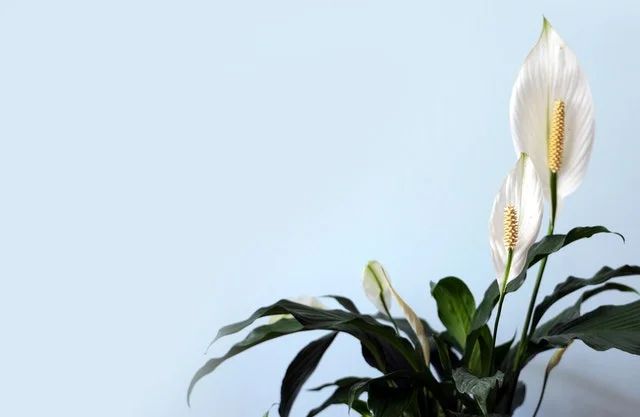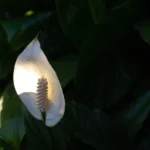Whenever you observe that a peace lily is drooping, the first thought that comes to mind is that you are not watering the Lily with enough water. Well, this may be true at times, but this might not be necessarily the case.
There could be other factors causing the peace lily to droop that are not so outrightly placed for everyone to see, such as those factors affecting the roots.
Table of Contents
Common Causes of Drooping Peace Lilies
Inadequate Water
Whenever you observe a wilting peace Lily, especially in the morning hours after the Lily was wonderful the previous day, you would be right to assume a watering problem.
Peace lilies do well in tropical conditions and can withstand high amounts of water and humidity. Although peace lilies can put up with soggy conditions, they tend to wilt quickly at the first instance of inadequate water, signaling that you need water to the pot.
Whenever this is the issue, the peace Lily will recover soon, and it would be satisfying to realize that the plant only needed to be watered. Interestingly enough, too much water in a Peace Lily is an even bigger problem.
If you continuously water the peace Lily every day and realize that it displays wilting symptoms, you should know that you have a bigger problem to fix. Too much water in a peace Lily tends to stress its roots, causing them to die, which results in wilting.
To determine if the peace lily is waterlogged, you need to perform a finger test on the soil in the pot.
For a waterlogged peace Lily, you will realize that the soil is muddy, contrary to the normal, where the earth’s top inch is usually dry.
Whenever watering the Lily, you are advised to pour water into the pot until the water starts flowing from the drainage holes at the bottom of the pot. Also, make sure the container has drainage holes, and you should transplant lilies whose containers do not have these holes as this is the primary cause of waterlogging.
To save a waterlogged Lily, you need to devise a mechanism to reduce excess water. For instance, you can carefully uproot the plant from the pot and place it outdoors for a period of half an hour or a full hour to allow both the plant and the soil to lose excess water.
You should take this chance to inspect Lily’s roots to determine if waterlogging has killed the root system which could be hazardous. You will go through much more trouble to revive a waterlogged lily than it would cost you to restore a thirsty one.
To maintain a suitable watering procedure, you should only water your plant after finger testing. You should water the Lily at intervals of one week or a few days, depending on the finger test result.
You certainly should not irrigate your Lily every day, but when you do, make sure the soil is drenched, and water is pouring from the drainage holes, after which you leave the Lily until the top inch of the earth is dry, before you can water it again.
Abnormalities In Temperature and Sunlight Exposure
It would be best to keep a keen note on the temperature conditions you expose a peace Lily. The optimum conditions under which you should expect the peace Lily to perform best is approximately 70 degrees Fahrenheit and above.
The optimum temperature of the Lily should not be allowed to drop below 60 degrees Fahrenheit. The effect of high temperatures on the Peace Lily is that too much water is lost to transpiration leading to wilting.
You will realize that if you stick to a strict watering routine and the temperatures change, the Peace Lily will droop, signaling you need to adjust the pattern to provide more water.
Too much exposure to direct sunlight causes Lily’s leaves to turn yellow then brown, leading to wilting and eventual death.
To tell if the Lily is exposed to too much sunlight, you should inspect the leaves for signs of the mentioned discoloration. You’d be intrigued to realize that the natural habitation of a peaceful Lily in a tropical rainforest is under the shade or canopy of other plants or trees.
Peace lilies, therefore, do not require large amounts of sunlight and can do perfectly well in a shaded area with low lighting.
Shock Due To Transplanting
More often than not, transplanted peace lilies tend to wither. Transplanting a peace Lily will take you a considerable amount of time under which the highly water-dependent peace Lily is not under a constant supply of water from the roots.
If the peace Lily does not have time to adapt to its new soil, the Lily is shocked and droops. You need to give the Lily a few days to adapt to this soil and possibly apply a few tricks to make your transplanting process more successful.
First of all, you are advised to repot the Lily to dry soil and water it afterwards. A scenario may arise where you find out that the plant has outgrown the pot’s size, in which case you will be required to subdivide the plant by cutting from the roots up and transplanting each new plant to an appropriately sized container.
After you have transplanted the Lily, you could add a bit of ordinary sugar to the water you use to irrigate the transplanted plant to increase the chances of success.
Although these might not work for all plants, you should try applying this trick. After all, in the worst-case scenario, the sugar will not harm the peace, Lily.
Poor Drainage Of The Soil In The Pot
As discussed, you will discover that peace lilies will require well-drained soils since waterlogged soil tends to kill their roots. Peace lilies can tolerate large amounts of water but not for too long.
You need to maintain the proper water balance for the Lily by using well-drained soil. The best earth for peace Lily would be a peat potting mix made up of compost manure and perlite components.
You should change the potting soil once after every one or two years since the potting soil accumulates chemicals and builds up salts resulting from fertilizer nourishments. This chemical buildup happens irrespective of whether use fertilizers or not.
Also, continuous watering intends to wash away nutrients, and the potting medium of the plant can no longer suffice the peace Lily. As such, there are times when you will need to repot the peace Lily to revive the plant.
Insect attack
Whenever you observe the peace Lily behaving abnormally, you consider all factors that could have led to the abnormality, and insects’ attacks are a great possibility.
Peace Lilies are placed in houses to purify the air, and consequently, insects’ attacks are rare. However, organisms such as mealybugs, spider mites, and aphids attack peace lilies.
Mealybugs destroy the leaves of peace Lilies by feeding on the cell-sap. Whenever you observe white fluffs on the leaves, this is an indication of a pest attack. To control this attack, you need to rub alcohol on the leaves of the plant.
Ways of Reviving a Drooping Peace Lily
Maintain Good Soil Drainage
If you identify that the problem causing the plant to droop is excess water, fixing this problem will be pretty straightforward.
It would be best if you created holes on the pot’s base to ensure that you do not get the soil waterlogged whenever you are watering the plant, and the excess water runs from the container through the holes.
This way, you will have solved the waterlogging problem. Excess water around the roots of a peace Lily blocks the root from accessing air, and they die.
As discussed, the tip here is inserting your finger up to the second knuckle into the soil; if the finger becomes too wet, then the soil is waterlogged.
Maintain A Good Watering Schedule
You’d be intrigued to realize that whenever blooming, peace lilies require a relatively larger of water than during regular times. This development indicates that you should water your Lily on a more adjusted schedule whenever it is blooming.
To keep the peace Lily from wilting, you will have to adjust your watering schedule according to the prevailing conditions.
For instance, during summer, you would be required to spray Lily’s leaves with distilled water to minimize water loss through the plant leaves.
Proper Sunlight Control
The effects of too much sunlight on a peace Lily lead to excessive transpiration and eventual wilting despite constant watering. To fix this problem, you should move the plant to a shade or partially lit area, such as away from doors or windows.
Again, the tip here is that you should choose a spot in your house or garden where the plant will receive enough sunlight to maintain it healthy and green, but not excess sunlight, which will cause wilting.
Tend To Rotting Roots
It would be appropriate that you take keen care to treat root rot caused by fungal infection and incorporate a thorough treatment of the soil, roots, and the water you use.
You will be required to;
- Change the earth in the pot
- Cut off the rotted part of the roots
- Clean the roots off fungal spores
- Use sterilizers on the potting container
- Use a healthy potting mixture.
After repotting, you might realize that the peace Lily might experience a bit of everyday stress, but it will recover soon enough.
Vitamin nourishments
Whenever you realize that the peace lilies droop and wilt too often after transplanting, maybe it’s about time you utilize a few vitamin nourishments to help with root development.
Vitamin B1 should be an excellent additive to help you achieve better root development. Alternatively, you could use other fertilizers to help the Lily with root development.
It would be best to take keen care not to apply excess fertilizer, leading to intoxication and burning associated with nitrogenous components.



